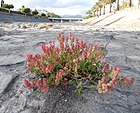Note: This is a project under development. The articles on this wiki are just being initiated and broadly incomplete. You can Help creating new pages.
Rumex vesicarius
Rumex vesicarius is an annual or perennial, rhizomatous herb growing up to 50 cm tall, strongly branched from the base. The edible leaves are gathered from the wild and consumed locally. The plant is sometimes cultivated for its edible leaves in Indonesia, and occasionally sold in local markets there.
Contents
[hide]- 1 Uses
- 2 Parts Used
- 3 Chemical Composition
- 4 Common names
- 5 Properties
- 6 Habit
- 7 Identification
- 8 List of Ayurvedic medicine in which the herb is used
- 9 Where to get the saplings
- 10 Mode of Propagation
- 11 How to plant/cultivate
- 12 Commonly seen growing in areas
- 13 Photo Gallery
- 14 References
- 15 External Links
Uses
[[:Category:Ayurvedic Herbs known to be helpful to treat |]], [[:Category:Ayurvedic Herbs known to be helpful to treat |]], [[:Category:Ayurvedic Herbs known to be helpful to treat |]], [[:Category:Ayurvedic Herbs known to be helpful to treat |]], [[:Category:Ayurvedic Herbs known to be helpful to treat |]], [[:Category:Ayurvedic Herbs known to be helpful to treat |]], [[:Category:Ayurvedic Herbs known to be helpful to treat |]], [[:Category:Ayurvedic Herbs known to be helpful to treat |]], [[:Category:Ayurvedic Herbs known to be helpful to treat |]], [[:Category:Ayurvedic Herbs known to be helpful to treat |]], [[:Category:Ayurvedic Herbs known to be helpful to treat |]].[1]
Parts Used
Chemical Composition
The concentration of the minerals ranged from 1790 to 3680 mg/100 g for calcium, 2.1–3.9 mg/100 g for copper, 24.1–42.5 mg/100 g for iron, 1320–2270 mg/100 g for magnesium, 2710–3230 mg/100 g for potassium, 846–1100 mg/100 g for sodium and 3.7–8.8 mg/100 g for zinc (atomic absorption spectrophotometer analysis).[2]
Common names
| Language | Common name |
|---|---|
| Kannada | Chukki soppu |
| Hindi | Chooka |
| Malayalam | |
| Tamil | Cukkan-kirai |
| Telugu | Chukka kura |
| Marathi | Amlavetasa |
| Gujarathi | |
| Punjabi | NA |
| Kashmiri | |
| Sanskrit | Amlavetasa |
| English | Bladder Dock, Blister sorrel |
Properties
Reference: Dravya - Substance, Rasa - Taste, Guna - Qualities, Veerya - Potency, Vipaka - Post-digesion effect, Karma - Pharmacological activity, Prabhava - Therepeutics.
Dravya
Rasa
Guna
Veerya
Vipaka
Karma
Prabhava
Habit
Identification
Leaf
| Kind | Shape | Feature |
|---|---|---|
Flower
| Type | Size | Color and composition | Stamen | More information |
|---|---|---|---|---|
| {{{5}}} |
Fruit
| Type | Size | Mass | Appearance | Seeds | More information |
|---|---|---|---|---|---|
Other features
List of Ayurvedic medicine in which the herb is used
Where to get the saplings
Mode of Propagation
How to plant/cultivate
A plant of the drier regions of the warm temperate to tropical zones, it has been grown with some success in more humid areas, such as Tanzania.[5]
Commonly seen growing in areas
Dry areas among loose stones, Gravelly slopes.
Photo Gallery
References
- Jump up ↑ Indian Medicinal Plants by C.P.Khare
- Jump up ↑ [1]
- Jump up ↑ Common names
- Jump up ↑ [Morphology]
- Jump up ↑ Cultivation
External Links
- Pages using duplicate arguments in template calls
- Ayurvedic Herbs known to be helpful to treat
- Herbs with Leaves used in medicine
- Herbs with Seeds used in medicine
- Herbs with common name in Kannada
- Herbs with common name in Hindi
- Herbs with common name in Tamil
- Herbs with common name in Telugu
- Herbs with common name in Marathi
- Herbs with common name in Sanskrit
- Herbs with common name in English
- Habit - Annual
- Index of Plants which can be propagated by Seeds
- Herbs that are commonly seen in the region of Dry areas among loose stones
- Herbs that are commonly seen in the region of Gravelly slopes
- Herbs





